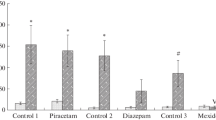Summary
Effects of scopolamine on avoidance conditioning of naive and previously trained mice and on habituation to the to-be-conditioned stimulus was studied by using a shuttle-box avoidance technique and a light as CS. The results show that the action of the drug depends on four major phenomena:
-
1.
A drug state in which learning is dissociated from learning under non drug state.
-
2.
A so called “amnestic” effect which disappears once the effect of the drug is over. This effect is evident as an impairment of the performance of previously trained animals.
-
3.
A photophobia due to the mydriatic effect of the drug, responsible for an enhanced sensitivity of the animals to luminous stimuli.
-
4.
A facilitatory effect of the drug on arousal regulating mechanisms in naive animals.
Nicotine exerted a facilitating effect on avoidance conditioning. The action of this cholinergic agent was not state dependent.
The effects of anticholinergic agents on conditioning and learning are interpreted in light of these findings.
Similar content being viewed by others
References
Armitage, A. K., and G. H. Hall: Further evidence relating to the mode of action of nicotine in the central nervous system. Nature (Lond.) 214, 977–979 (1967).
Bignami, G.: Effects of benactyzine and adiphenine on avoidance conditioning in a shuttle-box. Psychopharmacologia (Berl.) 5, 264–279 (1964).
Bindra, D., and H. Reichert: The nature of dissociation: effects of transitions between normal and barbiturate-induced states on reversal learning and habituation. Psychopharmacologia (Berl.) 10, 330–334 (1967).
Bohdanecky, Z., and M. E. Jarvik: Impairment of one-trial passive avoidance in learning mice by scopolamine, scopolamine methylbromide and physostigmine. Int. J. Neuropharmacol. 6, 217–222 (1967).
Bovet, D., and F. Bovet-Nitti: Action of nicotine on conditioned behavior of naive and pretrained rats. In Tobacco Alkaloids and Related Compounds, ed. by U. S. von Euler, pp. 125–142. Oxford: Pergamon Press 1965.
— —, and A. Oliverio: Effects of nicotine on avoidance conditioning of inbred strain of mice. Psychopharmacologia (Berl.) 10, 1–5 (1966).
Bovet-Nitti, F.: Facilitation of simultaneous visual discrimination by nicotine in the rat. Psychopharmacologia (Berl.) 10, 59–66 (1966).
Burešová, O., J. Bureš, Z. Bohdanecky, and T. Weiss: Effect of atropine on learning, extinction, retention and retrieval in rats. Psychopharmacologia (Berl.) 5, 225–263 (1964).
Carlton, P. L.: Cholinergic mechanisms in the control of behavior by the brain. Psychol. Rev. 70, 19–39 (1963).
—, and J. R. Vogel: Studies of the amnesic properties of scopolamine. Psychon. Sci. 3, 261–262 (1965).
Jacobsen, E., and E. Sonne: The effect of benzilic acid diethylaminoethylester HCl (Benactyzine) on stress-induced behavior in the rat. Acta pharmacol. (Kbh.) 11, 135–142 (1955).
Knapp, D. E., and E. F. Domino: The action of nicotine on the ascending reticular activating system. Int. J. Neuropharmacol. 1, 333–351 (1962).
Leaf, R. C., and S. A. Muller: Effects of scopolamine on operant avoidance acquisition and retention. Psychopharmachologia (Berl.) 9, 101–109 (1966).
Longo, V. G., G. P. von Berger, and D. Bovet: Action of nicotine and of the “ganglioplégiques centraux” on the electrical activity of the brain. J. Pharmacol. exp. Ther. 111, 349–359 (1954).
Lubow, R. E.: Latent inhibition: effects of frequency of nonreinforced preexposure of the CS. J. comp. physiol. Psychol. 60, 454–457 (1965).
Mennear, J. H., G. K. Samuel, M. H. Joffe, and J. K. Kodama: The effects of scopolamine and atropine on the performance of an exercise-avoidance test in dogs. Psychopharmacologia (Berl.) 9, 347–350 (1960).
Meyers, B.: Some effects of scopolamine on a passive avoidance response in rats. Psychopharmacologia (Berl.) 8, 111–119 (1965).
Oliverio, A.: Contrasting effects of scopolamine on mice trained simultaneously with two different schedules of avoidance conditioning. Psychopharmacologia (Berl.) 11, 39–51 (1967).
—, F. Bovet-Nitti et D. Bovet: Action de la scopolamine et des médicaments parasympatholitiques sur le conditionement d'évitement chez la souris. C.R. Acad. Sci. (Paris) 262, 1796–1801 (1966).
Overton, D. A.: State-dependent learning produced by depressant and atropinelike drugs. Psychopharmacologia (Berl.) 10, 6–31 (1966).
Pazzagli, A., and G. Pepeu: Amnesic properties of scopolamine and brain acetylcholine in the rat. Int. J. Neuropharmacol. 4, 291–299 (1964).
Ricci, G. F., and L. Zamparo: Electrocortical correlates of avoidance conditioning in the monkey. Their modifications with atropine and amphetamine. In: Pharmacology of Conditioning, Learning and Retention, pp. 269–283, ed. by M. J. Mikhel'son and V. G. Longo. Oxford: Pergamon Press 1965.
Sachs, E.: Dissociation of learning in rats and its similarities to dissociative states in man. In: Comparative Psychopathology, ed. by Zubin and Hunt, pp. 249 to 304. New York: Grune & Stratton 1967.
Samuel, G. K., J. K. Kodama, and J. H. Mennear: Effects of scopolamine and atropine and their quaternized salts on avoidance behavior in the monkey. Psychopharmacologia (Berl.) 8, 259–301 (1965).
Stein, L.: Habituation and stimulus novelty: a model based on classical conditioning. Psychol. Rev. 73, 352–356 (1966).
Vogel, J. R., R. A. Hughes, and P. L. Carlton: Scopolamine, atropine and conditioned fear. Psychopharmacologia (Berl.) 10, 409–416 (1967).
Author information
Authors and Affiliations
Additional information
This research was supported by grants from the Italian Consiglio Nazionale delle Ricerche and from Education and Research Foundation of the American Medical Association, Comittee for Research on Tobacco and Health.
Rights and permissions
About this article
Cite this article
Oliverio, A. Effects of scopolamine on avoidance conditioning and habituation of mice. Psychopharmacologia 12, 214–226 (1968). https://doi.org/10.1007/BF00403775
Received:
Issue Date:
DOI: https://doi.org/10.1007/BF00403775



